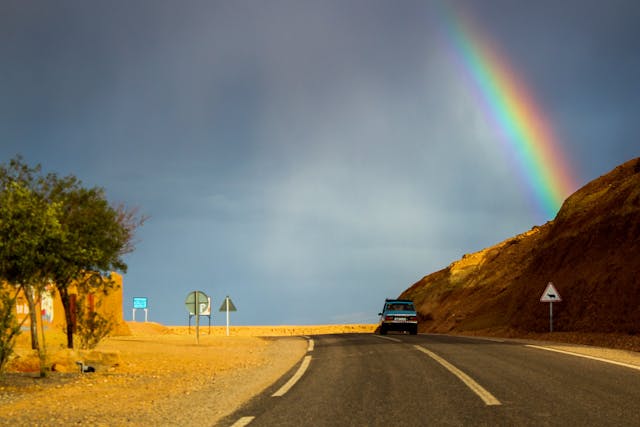
What makes a rainbow? A rainbow forms when light is refracted, reflected, and dispersed by raindrops in the air. The rainbow can only be seen from an angle of 42 degrees. The sun, or the source of light, must be behind you.
We can see a rainbow because of the speed of light through an object. And because of the speed of different wavelengths of light. Light in a vacuum travels at the speed of light, C, which is 277,792,458 m/s. However, when light enters different objects the speed of light slows down. The light comes in at a certain angle, hits the object and slows down, which changes its angle through the object. When the light exits the object, it speeds back up to the speed of light and returns to the same angle it came in on. Because it slowed down through the object, the exit point is not on the same line as the entry point, but the angle is the same, so the light travels parallel to the line it would have been on if the object hadn’t been there. You can see this when you put an object in a glass and half fill it with water. The part of the object that is under the water and the part of the object that is out of the water won’t align because the light is going slower through the water and leaving the glass at a different point than it would have done if the glass had been empty. This is refraction. This happens because light is a wave and the electrons around the atoms in the objects the light is passing through also make waves. If you pass one wave over another wave and the troughs and peaks line up, you will get a wave that is twice as big. If you pass one wave over another and the troughs of one wave line up with the peaks of another wave, the waves will cancel each other out. (This is what happens in noise cancelling headphones). And if you have two different waves, sometimes they will make each other smaller and sometimes bigger. That means, when the light is travelling through the object, it interacts with the waves that the electrons are producing and the two waves become one single wave, which moves more slowly than the wave of just light itself. When the light leaves the object, the second wave disappears and once the interference has gone, light returns to its original speed. The amount that light slows down in a medium is called its refractive index. The refractive index of a vacuum is 1, which means light travels at the speed of light. Water is 1.3, which means light travels 25% slower in water. Germanium has the highest refractive index. Light slows down by 75%.
The second thing is the different wavelengths of light slow down by different amounts. Longer wavelengths are slowed down less than shorter wavelengths. That means the longer wavelengths, reach the edge of the medium ever so slightly faster than the shorter wavelengths. The longer wavelengths are the reds and the shorter wavelengths are the blues. So, the reds exit first, at the top, and all of the colors between exit slightly differently until the blues exit last, which are at the bottom. And those are the colors of the rainbow.
To see a rainbow, there needs to be water in air. This often happens during or after a rainstorm, or with sea spray, or by a waterfall. The sun needs to be behind the person viewing the rainbow and the water drops need to be 42°away from the viewer. Light comes down from the sun and hits the water droplet, refracting. The slowed down light travels through the raindrop, hits the back of it, and is reflected back again. The different wavelengths leave the raindrop at slightly different angles, splitting into the colors of the rainbow. The red leaves the raindrop at an angle of 42 degrees and the blue leaves at 40. The light leaves at the opposite angle it entered the raindrop because of the reflection. If you are 42 degrees from it, you will see the perfect rainbow. If you are more or less, you will either see a very faint rainbow, or the light will be far above you or far below you. If you are at the right angle, then all of the raindrops will reflect back to you in a complete circle. You can only see the top part of the circle because the ground gets in the way. And that is what I learned today.
Sources
https://en.wikipedia.org/wiki/Rainbow
https://education.nationalgeographic.org/resource/rainbow
https://science.howstuffworks.com/nature/climate-weather/atmospheric/question41.htm
https://en.wikipedia.org/wiki/Speed_of_light
https://en.wikipedia.org/wiki/List_of_refractive_indices
Photo by Loubna Belmekki: https://www.pexels.com/photo/blue-car-travelling-on-gray-asphalt-road-570018/
